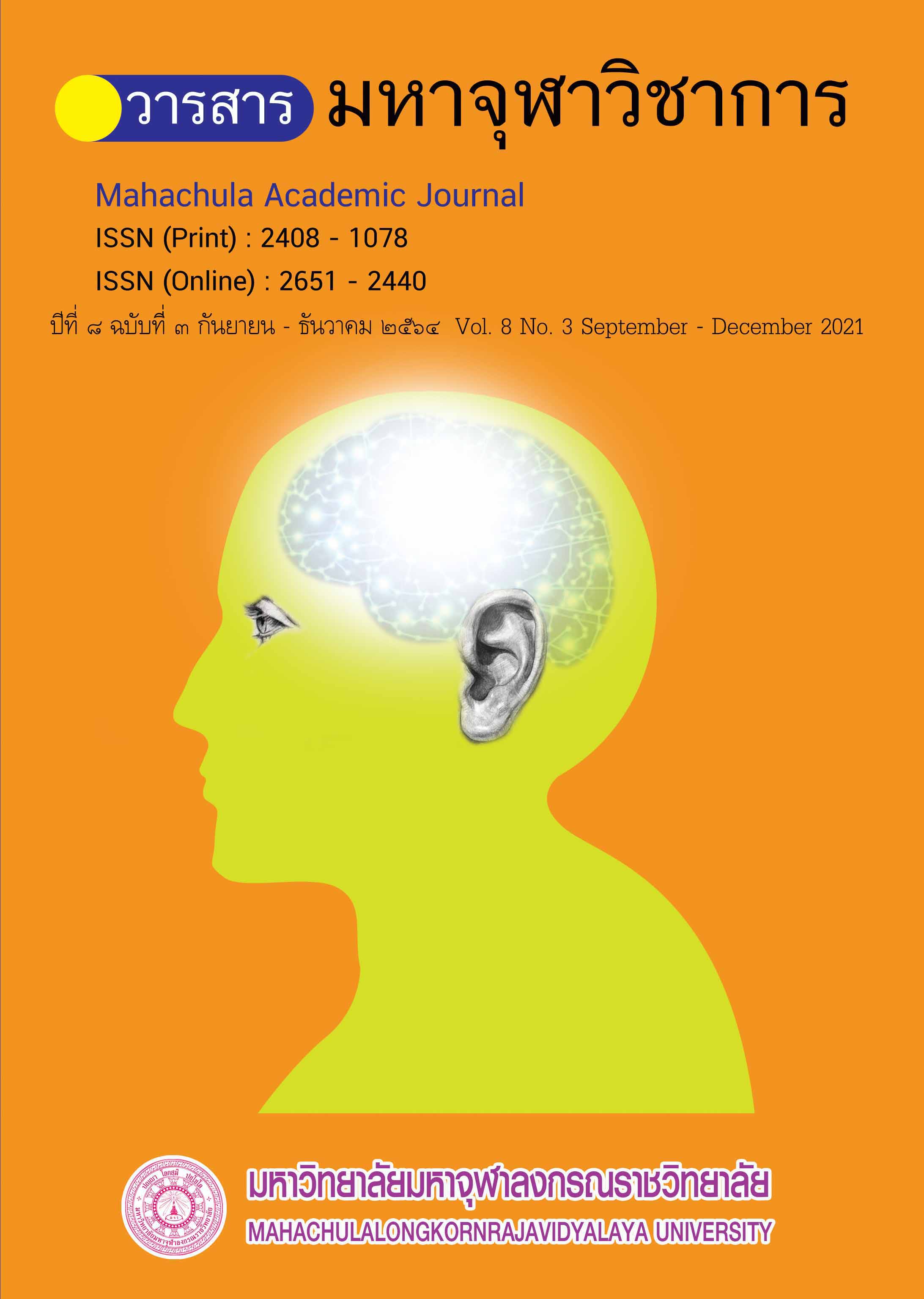Guidelines for the Development of Distance Learning through Information Technology of Schools under The Secondary Education Service Area office 7 in New Normal Era
Main Article Content
Abstract
The purposes of this study were (1) to examine current and desirable conditions of distance learning through information technology of school under the secondary education service area office 7 in new normal era, and (2) to investigate guidelines for the development of distance learning through information technologyof school under the secondary education service area office 7 in new normal era. The Mixed Methods Research methodology is used in the study. The sample of this research consisted of 325 teachers from 44 schools under the secondary education service area office 7. The informants from the interviews were five institutional directors, experts, and teachers under the secondary education service area office 7. The research instruments were questionnaires and structured interview forms. The statistics used for analyzing the data were frequency, percentage, mean, standard deviation and content analysis.
The research findings were as follows. (1) The current and desirable conditions of distance learning through information technology of school under the secondary education service area office 7 in new normal era as a whole were at a high level. (2) The guidelines for the development of distance learning through information technology of school under the secondary education service area office 7 in new normal era showed that qualified classrooms and professional development were the most needed. The guidelines included the following: (1) teachers should be developed to learn about distance learning through information technology, (2) teachers should do classroom research distance learning through information technology, (3) teachers should do individual development plans and should participate continuously in a community of professional learning, and (4) institutional administrators and related people should appoint a commission of supervision.
Article Details
References
เคนวัฒน์ ฤทธิรณ. “การดำเนินงานการจัดการศึกษาทางไกลผ่านดาวเทียมในโรงเรียนขนาดเล็ก สำกัดสำนักงานเขตพื้นที่การศึกษาประถมศึกษาสุรินทร์ เขต ๒”. วิทยานิพนธ์ปริญญามหาบัณฑิต. มหาวิทยาลัยราชภัฏบุรีรัมย์, ๒๕๖๐.
นภัสสรณ์ ฐิติวัฒนานันท์. “แนวทางการนำยุทธศาสตร์การจัดการศึกษาทางไกลผ่านเทคโนโลยีสารสนเทศไปสู่การปฏิบัติของโรงเรียนสังกัดสำนักงานคณะกรรมการการศึกษาขั้นพื้นฐาน”. วิทยานิพนธ์ปริญญามหาบัณฑิต. จุฬาลงกรณ์มหาวิทยาลัย, ๒๕๕๙.
นิดา หมั่นดี. “การพัฒนาระบบจัดการคลังข้อสอบและการสอบผ่านอินเทอร์เน็ต”. วารสารวิชาการและวิจัย มทร. พระนคร ฉบับพิเศษ การประชุมวิชาการมหาวิทยาลัยเทคโนโลยีราชมงคล ครั้งที่ ๕, (๒๕๕๖) ; ๔๘-๕๗.
ยอดชาย มานิ่ม. “แนวทางการดำเนินงานการจัดการเรียนการสอนทางไกลผ่านดาวเทียมของโรงเรียนสังกัดสำนักงานเขตพื้นที่การศึกษาประถมศึกษานครสวรรค์ เขต ๒”. ในการประชุมสัมมนาวิชาการ ราชภัฎนครสวรรค์วิจัย ครั้งที่ ๑. นครสวรรค์ : มหาวิทยาลัยนครสวรรค์, ๒๕๖๐.
ยุพาภรณ์ ติรไพรวงศ์. “การพัฒนาการจัดการเรียนการสอนผ่านชุมชนแห่งการเรียนรู้ทางวิชาชีพ : แนวทางการพัฒนาผู้สอนและผู้เรียน” . วารสารวิทยาลัยพยาบาลบรมราชชนนีกรุงเทพ. ปีที่ ๓๔ ฉบับที่ ๒ (๒๕๖๑) ; ๑๖๔-๑๗๒.
ศิริชัย กาญจนวาสี. “สถิติประยุกต์สำหรับการวิจัย” พิมพ์ครั้งที่ ๖. กรุงเทพมหานคร : โรงพิมพ์แห่งจุฬาลงกรณ์ มหาวิทยาลัย, ๒๕๕๕.
ศิษฏ์ชนา ดวงบาล. “แนวทางการพัฒนาครูด้านการใช้งานเทคโนโลยีสารสนเทศเพื่อการจัดการเรียนการสอนโรงเรียนวัดแม่แก้ดน้อย สังกัดสำนักงานเขตพื้นที่การศึกษาประถมศึกษาเชียงใหม่ เขต ๒”. วารสารพุทธศาสตร์ศึกษา. ปีที่ ๑๐ ฉบับที่ ๑ (๒๕๖๒) ; ๒๔๒-๒๕๓.
ศูนย์พัฒนาคุณภาพการศึกษาด้วยเทคโนโลยีการศึกษาทางไกล. “แนวทางการดำเนินงานพัฒนาคุณภาพการศึกษาทางไกลผ่านเทคโนโลยีสานสนเทศ (DLIT)”. กรุงเทพมหานคร : อักษรไทย, ๒๕๕๙.
สุนันท์ สีพายและไพฑูรย์ สินลารัตน์. “เปลี่ยนผ่านการศึกษาไทยสู่ การศึกษา ๔.๐”. วารสารการวัดผลการศึกษา มหาวิทยาลัยมหาสารคาม. ปีที่ ๒๔ ฉบับที่ ๒ (๒๕๖๑) ; ๑๓-๒๗.
สำนักงานเลขาธิการสภาการศึกษา. “สภาวะการศึกษาไทยปี ๒๕๕๙/๒๕๖๐ แนวทางการปฏิรูปการศึกษาไทยเพื่อก้าวสู่ยุค Thailand ๔.๐”. กรุงเทพมหานคร : พริกหวานกราฟฟิค, ๒๕๖๑.
สุวิมล ว่องวาณิช. การวิจัยประเมินความต้องการจำเป็น. พิมพ์ครั้งที่ ๓. กรุงเทพมหานคร : จุฬาลงกรณ์มหาวิทยาลัย, ๒๕๕๕.
อภินันท์ สีขำ. “แนวทางพัฒนาการจัดการเรียนการสอนทางไกลผ่านดาวเทียมของโรงเรียนขนาดเล็ก สังกัดสำนักงานเขตพื้นที่การศึกษาประถมศึกษากำแพงเพชรเขต ๑”. ใน รายงานสืบเนื่องการประชุมสัมมนาวิชาการ การนำเสนอผลงานวิจัยระดับชาติ เครือข่ายบัณฑิตศึกษา มหาวิทยาลัยราชภัฏภาคเหนือ ครั้งที่ ๑๗. (พิษณุโลก : มหาวิทยาลัยราชภัฎพิบูลสงคราม, ๒๕๖๐) ; ๙๘๖ -๙๙๙.
ภูษิมา ภิญโญสินวัฒน์. การจัดการเรียนการสอนอย่างไรในสถานการณ์โควิด-๑๙ : จากบทเรียนต่างประเทศสู่การจัดการเรียนรู้ของไทย. [ออนไลน์]. แหล่งที่มา: https://tdri.or.th/๒๐๒๐/๐๕/examples-of-teaching-and-learning-in-covid-๑๙-pandemic/ [๕ กรกฏาคม ๒๕๖๓].
Ramsay and Grant. Teaching and Learning with Information and Communication Technology: Success through a Whole School Approach. [Online]. Avaliable : https://files.eric.ed.gov/fulltext/ED๔๖๒๙๔๓.pdf [๕ กรกฏาคม ๒๕๖๓].


